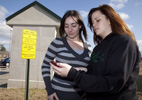
Lion Traxx Shuttle launches GPS tracking service
Contact: Elise Doster
3/2/10
Click on thumbnail for high resolution photo
Southeastern students Rachel Domiano, left, and Maggie Rownd, check the location of the next Lion Traxx shuttle bus on campus.
HAMMOND – Students at Southeastern Louisiana University no longer have to wonder when the next Lion Traxx shuttle is coming thanks to a GPS “Bus Tracking System” designed by a Southeastern professor.
Students waiting for rides to class or back to their cars can now view shuttle locations via Internet-enabled smartphones or online by visiting www.selu.edu/traxx, which shows a map of the Southeastern bus route. The system provides a new extra convenience factor to the shuttle service, which transported 105,603 passengers in the fall of 2009.
The university’s four buses are denoted by color on the Web site and move across the map in real time. Implemented in January, the system helps students make decisions about whether to wait for a shuttle or walk to their destinations. Shuttles typically make pickups every 10-15 minutes.
Although Web browsers Firefox and Safari automatically refresh bus locations every 15 seconds, those using Internet Explorer need to refresh the site themselves to view changing bus locations. If a cell phone has Internet and GPS capabilities, some systems will allow users to view their personal location in relation to the buses.
“The system doesn’t give an exact time the bus will arrive, but it gives students an idea of where the bus is, which helps them with time management,” said Jim McHodgkins, assistant vice president for student affairs.
Developed by IT professor and Southeastern’s Chief Information Officer Mike Asoodeh, the “Bus Tracking System” was created a few years ago with the intent of serving as a safety product for children. Asoodeh said Ray DeJean and Russell Barger of the university’s Administrative Computing division were instrumental in implementing the system in the Lion Traxx shuttles.
“I started working on the system when I saw kids standing on the street waiting for a school bus, sometimes in the dark. I thought it would be helpful to know if the bus is running late or is stuck in traffic,” Asoodeh said.
Though Southeastern is currently only using a portion of Asoodeh’s system, the technology also has RFID (Radio Frequency Identification) and landline communication capabilities. These additions allow schools to track when students are on or off the bus, while also alerting parents and caregivers of an approaching school bus via telephone.
McHodgkins said Lion Traxx might make further advancements to the tracking system by including other aspects of Asoodeh’s system, such as the RFID safety feature to locate students in case of an emergency. Students, faculty and staff are currently asked to show their ID before getting on Lion Traxx, but an RFID addition would provide the Lion Traxx staff with additional student classification information.
The university shuttle service, Lion Traxx, started in the fall of 2007 with one bus and one driver and has grown to four buses and three full-time drivers. Purchased in part through Student Government Association funding, the shuttles run from 7 a.m.-4 p.m. Monday-Friday, and Lion Traxx signs mark all campus bus stops.
Gary Prescott, assistant director of shuttle services, said Asoodeh helped Southeastern save a significant amount of money by allowing the university to use his tracking system. Southeastern only paid for the start-up equipment; the only other expense is the phone service required for the system.
The buses are currently tracked by GPS-enabled smartphones placed inside the Lion Traxx buses that relay their locations to the Lion Traxx Web site. Students are currently charged a $6 fee per semester and $3 in the summer to maintain all Lion Traxx services.
“The system helps with parking problems because people are more willing to park farther away if they can take a bus,” Asoodeh said.
More News...
